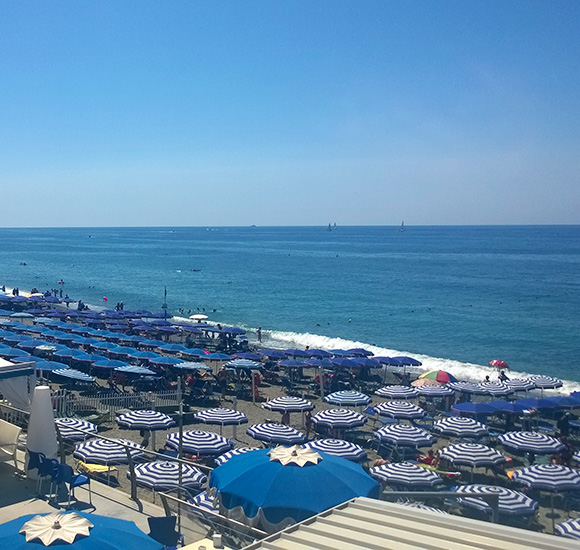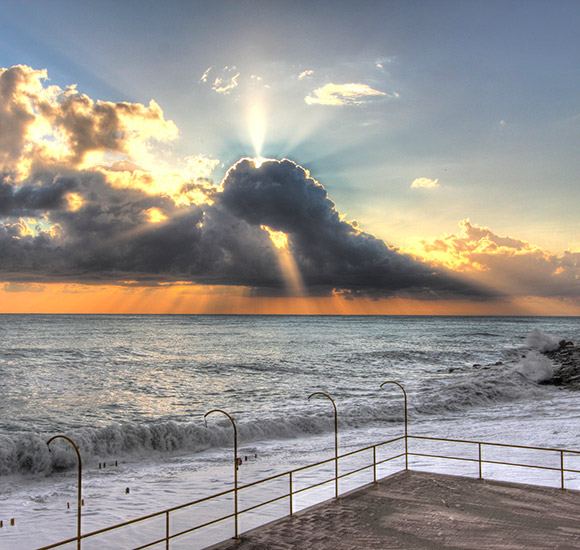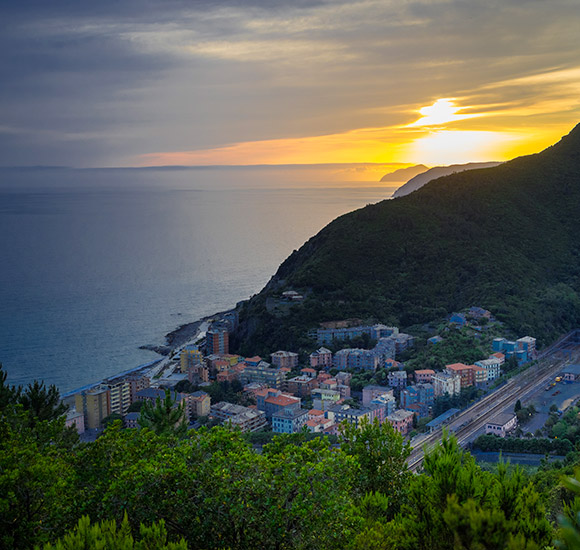best rate + insurance coverage
best rate + insurance coverage
Deiva Marina
Suspended between the sky and the sea, perhaps a bit in time too… that’s the Riviera you don’t expect: rich in history, culture and traces of a distant past, as well as in natural beauty spots and panoramic views...
Suspended between the sky and the sea, perhaps a bit in time too… that’s the Riviera you don’t expect: rich in history, culture and traces of a distant past, as well as in natural beauty spots and panoramic views.
A long, long beach of the fine sand and tiny coloured pebbles, in different proportions depending on the currents and tides, enclosed between two crowns of cliffs. The sea, open on the horizon, clear but harsh, almost wild, so that you need take only three steps before the bottom seems to disappear from under your feet. The mild climate, lightly touched by the breeze or by the west wind.
This is the visiting card of Deiva Marina and of the whole territory, a point of interest for tourists who arrive from every part of the globe and the pride of its inhabitants; yet this passport may even become a bit of an encumbrance, because it risks distracting attention from the profound quality of a land rich in history and culture, situated on the crossroad of itineraries that range from the Nature Park of the Cinque Terre, an amazing landscape created by man’s toil, laboriously winning back the land from the sea, to the upper Monti Liguri, an excursion itinerary with lots of old towns, the charm of which has remained intact despite the passing of time, and then to the Gulf of Tigullio which, alongside the most famous tourist resorts, offers quiet spots far from the madding crowd and little hidden bays, an almost unexpected gift for the traveller who knows how to seek them out.


You reach Deiva from the hills, coming down a series of slow hairpin bends from the Via Aurelia to the sea; or you can arrive following the coast from Sestri Levante, through the old railway tunnel, following a route that regularly alternates shadow with glaring light.
In both cases you approach it slowly, gradually, savouring it in tiny fractions, in fragments of images that the eye never has time to recompose...
You reach Deiva from the hills, coming down a series of slow hairpin bends from the Via Aurelia to the sea; or you can arrive following the coast from Sestri Levante, through the old railway tunnel, following a route that regularly alternates shadow with glaring light. In both cases you approach it slowly, gradually, savouring it in tiny fractions, in fragments of images that the eye never has time to recompose. In the end you are surprised when you finally succeed in looking out over the whole valley, lingering on every minute detail; or when you find yourself suddenly so close to the sea and you can fill your lungs with the air that smells of iodine and feast your eyes on the colours, from the pastel pink and yellow of the houses to the blue and greenish hues of the Mediterranean.
The town is divided into two parts: the old centre, close to the hill, with its houses clinging to the hillside, grouped closely together in a centuries-old embrace, forming an intricate and intriguing mosaic of tiles and plaster, Genoese windows with a stone surround and wrought iron railings, dark red geraniums on the balconies and welcoming Madonnas over the doors; and the Marina, built entirely after the Second World War, with its neat geometrical pattern of streets and squares. They are two different yet interconnected realities, two different worlds living side by side, perhaps by coincidence, perhaps to tease.
In the centre of the oldest part stands the eighteenth-century parish church dedicated to St. Anthony Abbot.
It is particularly interesting on account of the church square, with its typical pattern of Ligurian stone laid “à risseau” (a kind of mosaic of smoothed pebbles, laid out to form patterns with a maritime theme). In front of the church is a late medieval tower with a square plan, topped with projecting battlements...
In the centre of the oldest part stands the eighteenth-century parish church dedicated to St. Anthony Abbot.
It is particularly interesting on account of the church square, with its typical pattern of Ligurian stone laid “à risseau” (a kind of mosaic of smoothed pebbles, laid out to form patterns with a maritime theme). In front of the church is a late medieval tower with a square plan, topped with projecting battlements. A second tower with a round plan stood near the sea and its ruins can still be seen today, covered with ivy.
Both were built as military watch-towers to guard against the danger of raids by Turkish and Barbary pirates. The complex probably formed a link in a visual communication system, triangulated with other guard positions.
Following a natural and historic itinerary, you can go from the old town centre of Deiva up to the higher land, where you find the outlying districts of Mezzema, Piazza and Passano, small groups of houses scattered on the hillside, whose inhabitants later moved down into the valley to found the new centre. The most interesting sign of the antiquity of the settlements in these areas is the church of the Assunta, considered the first parish church in the district, built by Ita and Oberto, who were perhaps the founders of the families that ruled Passano, around 1002, on a broad level terrace that is now a short distance from the Piazza district. The building is well-known because it contains one of the most significant written records of the evangelisation of the territory: an old inscription of the late seventh-eighth century engraved on a marble slab, which gives the text of what claims to be a “letter from Jesus Christ sent from Heaven”, kept along with the dedication stone of the church itself.
The Latin text of the early Christian inscription harshly reminds the faithful to observe Sunday as a day of rest, threatening the worst calamities and punishments to defaulters.


Farther up, we come to the hill of San Nicolao, which dominates the valley of Deiva.
On the northern face, at a height of about 800 metres above sea level, recent excavations have brought to light a medieval hospital complex comprising a church with a single nave and a transept with a triple apse, dating back to around the twelfth-thirteenth century, and a smaller adjacent building...
Farther up, we come to the hill of San Nicolao, which dominates the valley of Deiva. On the northern face, at a height of about 800 metres above sea level, recent excavations have brought to light a medieval hospital complex comprising a church with a single nave and a transept with a triple apse, dating back to around the twelfth-thirteenth century, and a smaller adjacent building. A little to the south, the remains of a larger building with a rectangular plan have been found; this was probably a hostel for pilgrims and wayfarers.
The discovery of ceramic containers, earthenware jars and potshards, and of other small items in everyday use (including a few coins), has made it possible to confirm the date but also to put forward interesting hypotheses concerning the dietary habits of the period, from the production of loaves baked in shallow earthenware pans, a tradition still very much alive in the area, as far as Lunigiana, to the production of soups and polenta made from cereals. However, these signs are not only ones to be found in the territory, nor even the oldest ones, since in the area of Monte Carmo, near the district of Mezzema, jasper arrow tips have been found, as well as fragments of ceramic and small stone items that date back to the period between the Copper and the Bronze Age: traces of ancient settlements and items that cast our minds back to a distant, ancestral past, before the dawn of history.
What to do
